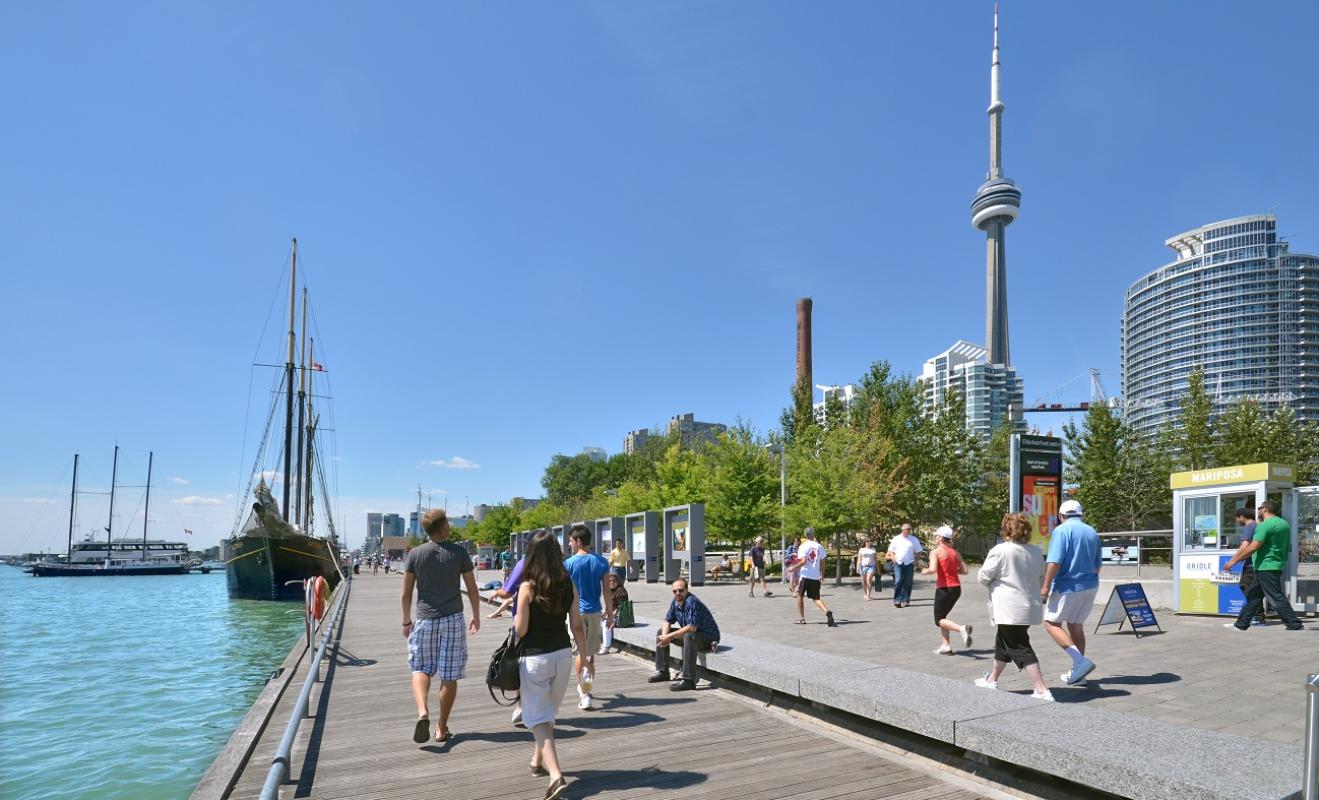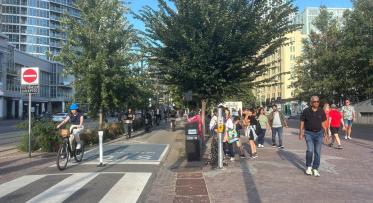Water's Edge Promenade & Boardwalk (West)
The continuous water's edge promenade and boardwalk will become an iconic and defining feature of Toronto’s revitalized waterfront.
A key feature of the award-winning plan for Toronto’s downtown waterfront is a water’s edge promenade and boardwalk that provides continuous public access to the lake. In the central waterfront area, the 1.8 kilometre long promenade will stretch from Ireland Park (south of the Canada Malting silos) to York Street. Another kilometre-long water’s edge promenade and boardwalk in East Bayfront will stretch from just east of Canada's Sugar Beach to the Parliament Slip. In all, there will be more than three kilometres of direct, public access to the water’s edge in downtown Toronto.
Quick Facts
The water’s edge promenade and boardwalk work together to provide a generous amount of space along the lakefront. In the central waterfront the promenade will be composed of a 12-metre wide granite walkway planted with a double-row of native maple trees, and a slightly lowered wooden 8-metre wide boardwalk cantilevered over the water. The selection of materials is distinctly Canadian: wood and granite with a maple leaf mosaic pattern.
The way people experience the water’s edge from either the promenade or boardwalk will be quite different. Along the promenade, a row of mature trees lining each side will create a French-style allée by the lake sheltering pedestrians from sun and wind. The boardwalk, open to the elements, gives pedestrians full exposure to the lake.
A first phase of water’s edge promenade and boardwalk was completed in 2006 around York and John Quays at Harbourfront Centre. This work, which improved public access to the lake by completely restructuring the water’s edge in the area, helped to inspire the design for the grand, civic water’s edge promenade and boardwalk planned for both the central waterfront and East Bayfront.
connecting the water's edge
In addition, five iconic pedestrian footbridges will span the Simcoe, Police Basin, Rees, Peter and Spadina slips connecting the gaps in the boardwalk and allow people to stroll along the water’s edge. This unique experience will create, for the first time, direct connectivity and a waterfront link between the major destinations that line our central waterfront, including the Music Garden, HtO Park, Harbourfront Centre and Queens Quay Terminal.
healthy mature trees
A double row of mature trees is a key ingredient in the design of the water’s edge promenade. Waterfront Toronto is working with leading tree experts and employing the latest technologies to ensure that planted trees mature and thrive. Research shows that a major impediment to establishing trees in urban areas is the lack of an adequate volume of soil for tree root growth. The soils under pavement is highly compacted and usually often stops tree roots from growing, causing the trees to die prematurely after seven to ten years.
New tree planting technology, which installs a tiered web of rigid boxes — called silva cells — is designed to house an average of 30 cubic metres of nutrient soil per tree. These reinforced cells provide support for the soil so it won’t compact under the weight of the pavement above. The system allows tree roots to spread and thrive resulting in healthier mature trees.
Aquatic habitat
The water’s edge improvements are not only at ground level. The water’s edge promenade and boardwalk is also an important part of Waterfront Toronto’s efforts to improve water quality and fish habitats in Toronto’s inner harbour.
During the construction of the boardwalk, Waterfront Toronto will create new aquatic habitat using a variety of different measures including the installation of boulders, smaller aggregate gravel, tree roots and large logs. This habitat will provide an environment for fish to reproduce, live and grow. Aquatic plants will also be able to root in these habitats providing both food and shelter.


